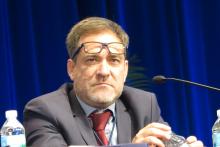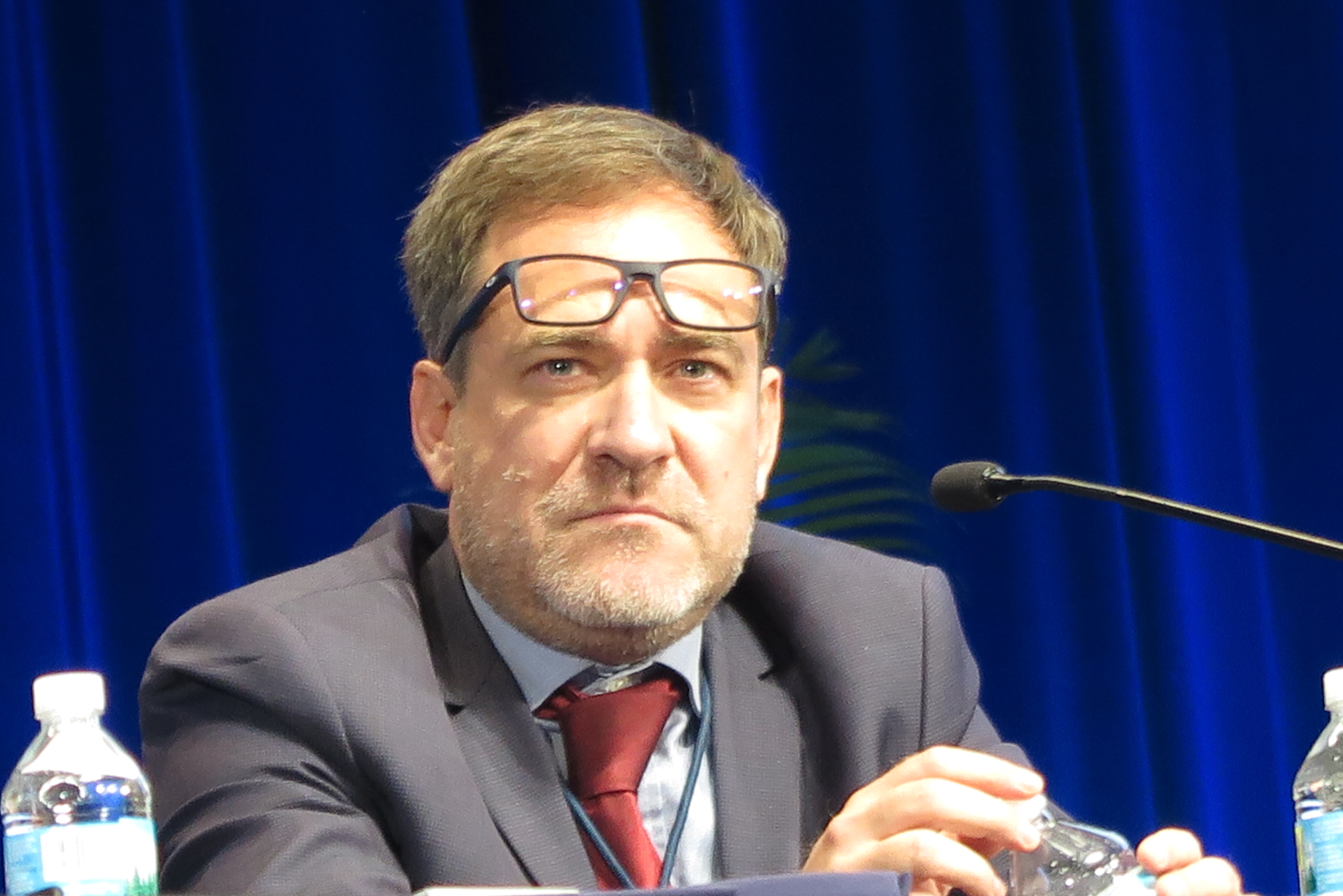User login
CHICAGO – Adding short-term androgen deprivation therapy (ADT) to radiotherapy as salvage treatment after radical prostatectomy was associated with significantly better metastasis-free survival at nearly 10 years compared with salvage radiation alone, long-term results of a randomized phase 3 trial show.
After a median follow-up of 112 months (9.3 years), the metastasis-free survival (MFS) rate for 369 patients assigned to receive salvage radiation and short-term goserelin was 75%, compared with 69% for 374 patients randomized to radiation alone (P = .034), reported Nicolas Magné, MD, from Jean Monnet Saint Etienne University in Saint-Priest en Jarez, France.
“We can conclude and do believe that short ADT, only two injections at 3-month intervals, could increase MFS at 10 years compared to radiation alone in patients with rising PSA after initial prostatectomy,“ he said at the annual meeting of the American Society of Clinical Oncology.
There was no significant difference, however, in the secondary endpoint of overall survival at 10 years.
Dr. Magné and co-investigators in the GETUG-AFU 16 trial had previously reported that after a median follow-up of 5.3 years, patients assigned to radiation plus goserelin were significantly more likely to be free of biochemical or clinical progression at 5 years than patients assigned to radiotherapy alone (80% vs, 62%, hazard ratio [HR] 0.50, P less than .0001).
The open-label trial enrolled men 18 or older from 43 French centers who had been treated for a histologically confirmed adenocarcinoma of the prostate but had not received prior androgen deprivation therapy (ADT) or pelvic radiation. The patients had either stage pT2 or pT3 cancers, or stage pT4a with invasive disease limited to the bladder neck. The patients all had biochemical failure, defined as a rising prostate-specific antigen (PSA) of 0.2 to 2.0 mcg/L following radical prostatectomy, with no clinically evident disease.
The patients were randomly assigned to receive standard salvage radiotherapy either alone or with hormonal therapy. Randomization was stratified by investigational site, radiotherapy modality, and prognosis.
Radiotherapy consisted of either 3-D conformal radiotherapy or intensity modulated radiotherapy, delivered in 66 Gy doses divided into 33 fractions of 2 Gy each 5 days a week for 7 weeks.
Patients assigned to hormonal therapy in addition to radiation received one subcutaneous injection of goserelin 10.8 mg on the first day of radiation, and a second injection 3 months later.
Progression-free survival (PFS), the primary endpoint, was significantly better with the combination than with radiation alone for both low-risk patients (HR 0.47, 95% confidence interval [CI] 0.28-0.80), and high-risk patients (HR 0.56, CI 0.44-0.83).
As noted before, metastasis-free survival was also significantly better in the combination arm ( HR, 0.73, P = .034) at 10 years.
Invited discussant Daniel Spratt, MD, from the University of Michigan in Ann Arbor, commented that the study results “do show, just like they did in 2016, that bicochemical control is improved, which is linked to their primary endpoint of PFS, but I always caution that this alone will always be improved with testosterone suppression.”
He noted that if you give ADT to patients with low-risk prostate cancer “that we don’t usually even treat today,” adding hormonal therapy will produce a nearly identical improvement in biochemical control, suggesting more of a signal than a clinical benefit.
The improvement in MFS, however, is indeed a clinical benefit, “but it is a small difference, and one thing to note is that when you give these patients about 6 months of hormonal therapy, depending on the age of the patient, it can be about 6 months until they recover testosterone, and at their median follow-up, you can see that the delay in MFS, which is usually the trigger to start hormone therapy, is about 12 months. So it’s important when you counsel these patients that [for] about potentially 6 months to a year of symptoms you may delay the need for hormone therapy by about 12 months,” he said.
The study was supported by UNICANCER and AstraZeneca. Dr. Magné reported no relevant disclosures. Dr. Spratt reported amconsulting or advisory role with Blue Earth Diagnostics and Janssen Oncology.
SOURCE: Magn é D et al. ASCO 2019. Abstract 5001.
CHICAGO – Adding short-term androgen deprivation therapy (ADT) to radiotherapy as salvage treatment after radical prostatectomy was associated with significantly better metastasis-free survival at nearly 10 years compared with salvage radiation alone, long-term results of a randomized phase 3 trial show.
After a median follow-up of 112 months (9.3 years), the metastasis-free survival (MFS) rate for 369 patients assigned to receive salvage radiation and short-term goserelin was 75%, compared with 69% for 374 patients randomized to radiation alone (P = .034), reported Nicolas Magné, MD, from Jean Monnet Saint Etienne University in Saint-Priest en Jarez, France.
“We can conclude and do believe that short ADT, only two injections at 3-month intervals, could increase MFS at 10 years compared to radiation alone in patients with rising PSA after initial prostatectomy,“ he said at the annual meeting of the American Society of Clinical Oncology.
There was no significant difference, however, in the secondary endpoint of overall survival at 10 years.
Dr. Magné and co-investigators in the GETUG-AFU 16 trial had previously reported that after a median follow-up of 5.3 years, patients assigned to radiation plus goserelin were significantly more likely to be free of biochemical or clinical progression at 5 years than patients assigned to radiotherapy alone (80% vs, 62%, hazard ratio [HR] 0.50, P less than .0001).
The open-label trial enrolled men 18 or older from 43 French centers who had been treated for a histologically confirmed adenocarcinoma of the prostate but had not received prior androgen deprivation therapy (ADT) or pelvic radiation. The patients had either stage pT2 or pT3 cancers, or stage pT4a with invasive disease limited to the bladder neck. The patients all had biochemical failure, defined as a rising prostate-specific antigen (PSA) of 0.2 to 2.0 mcg/L following radical prostatectomy, with no clinically evident disease.
The patients were randomly assigned to receive standard salvage radiotherapy either alone or with hormonal therapy. Randomization was stratified by investigational site, radiotherapy modality, and prognosis.
Radiotherapy consisted of either 3-D conformal radiotherapy or intensity modulated radiotherapy, delivered in 66 Gy doses divided into 33 fractions of 2 Gy each 5 days a week for 7 weeks.
Patients assigned to hormonal therapy in addition to radiation received one subcutaneous injection of goserelin 10.8 mg on the first day of radiation, and a second injection 3 months later.
Progression-free survival (PFS), the primary endpoint, was significantly better with the combination than with radiation alone for both low-risk patients (HR 0.47, 95% confidence interval [CI] 0.28-0.80), and high-risk patients (HR 0.56, CI 0.44-0.83).
As noted before, metastasis-free survival was also significantly better in the combination arm ( HR, 0.73, P = .034) at 10 years.
Invited discussant Daniel Spratt, MD, from the University of Michigan in Ann Arbor, commented that the study results “do show, just like they did in 2016, that bicochemical control is improved, which is linked to their primary endpoint of PFS, but I always caution that this alone will always be improved with testosterone suppression.”
He noted that if you give ADT to patients with low-risk prostate cancer “that we don’t usually even treat today,” adding hormonal therapy will produce a nearly identical improvement in biochemical control, suggesting more of a signal than a clinical benefit.
The improvement in MFS, however, is indeed a clinical benefit, “but it is a small difference, and one thing to note is that when you give these patients about 6 months of hormonal therapy, depending on the age of the patient, it can be about 6 months until they recover testosterone, and at their median follow-up, you can see that the delay in MFS, which is usually the trigger to start hormone therapy, is about 12 months. So it’s important when you counsel these patients that [for] about potentially 6 months to a year of symptoms you may delay the need for hormone therapy by about 12 months,” he said.
The study was supported by UNICANCER and AstraZeneca. Dr. Magné reported no relevant disclosures. Dr. Spratt reported amconsulting or advisory role with Blue Earth Diagnostics and Janssen Oncology.
SOURCE: Magn é D et al. ASCO 2019. Abstract 5001.
CHICAGO – Adding short-term androgen deprivation therapy (ADT) to radiotherapy as salvage treatment after radical prostatectomy was associated with significantly better metastasis-free survival at nearly 10 years compared with salvage radiation alone, long-term results of a randomized phase 3 trial show.
After a median follow-up of 112 months (9.3 years), the metastasis-free survival (MFS) rate for 369 patients assigned to receive salvage radiation and short-term goserelin was 75%, compared with 69% for 374 patients randomized to radiation alone (P = .034), reported Nicolas Magné, MD, from Jean Monnet Saint Etienne University in Saint-Priest en Jarez, France.
“We can conclude and do believe that short ADT, only two injections at 3-month intervals, could increase MFS at 10 years compared to radiation alone in patients with rising PSA after initial prostatectomy,“ he said at the annual meeting of the American Society of Clinical Oncology.
There was no significant difference, however, in the secondary endpoint of overall survival at 10 years.
Dr. Magné and co-investigators in the GETUG-AFU 16 trial had previously reported that after a median follow-up of 5.3 years, patients assigned to radiation plus goserelin were significantly more likely to be free of biochemical or clinical progression at 5 years than patients assigned to radiotherapy alone (80% vs, 62%, hazard ratio [HR] 0.50, P less than .0001).
The open-label trial enrolled men 18 or older from 43 French centers who had been treated for a histologically confirmed adenocarcinoma of the prostate but had not received prior androgen deprivation therapy (ADT) or pelvic radiation. The patients had either stage pT2 or pT3 cancers, or stage pT4a with invasive disease limited to the bladder neck. The patients all had biochemical failure, defined as a rising prostate-specific antigen (PSA) of 0.2 to 2.0 mcg/L following radical prostatectomy, with no clinically evident disease.
The patients were randomly assigned to receive standard salvage radiotherapy either alone or with hormonal therapy. Randomization was stratified by investigational site, radiotherapy modality, and prognosis.
Radiotherapy consisted of either 3-D conformal radiotherapy or intensity modulated radiotherapy, delivered in 66 Gy doses divided into 33 fractions of 2 Gy each 5 days a week for 7 weeks.
Patients assigned to hormonal therapy in addition to radiation received one subcutaneous injection of goserelin 10.8 mg on the first day of radiation, and a second injection 3 months later.
Progression-free survival (PFS), the primary endpoint, was significantly better with the combination than with radiation alone for both low-risk patients (HR 0.47, 95% confidence interval [CI] 0.28-0.80), and high-risk patients (HR 0.56, CI 0.44-0.83).
As noted before, metastasis-free survival was also significantly better in the combination arm ( HR, 0.73, P = .034) at 10 years.
Invited discussant Daniel Spratt, MD, from the University of Michigan in Ann Arbor, commented that the study results “do show, just like they did in 2016, that bicochemical control is improved, which is linked to their primary endpoint of PFS, but I always caution that this alone will always be improved with testosterone suppression.”
He noted that if you give ADT to patients with low-risk prostate cancer “that we don’t usually even treat today,” adding hormonal therapy will produce a nearly identical improvement in biochemical control, suggesting more of a signal than a clinical benefit.
The improvement in MFS, however, is indeed a clinical benefit, “but it is a small difference, and one thing to note is that when you give these patients about 6 months of hormonal therapy, depending on the age of the patient, it can be about 6 months until they recover testosterone, and at their median follow-up, you can see that the delay in MFS, which is usually the trigger to start hormone therapy, is about 12 months. So it’s important when you counsel these patients that [for] about potentially 6 months to a year of symptoms you may delay the need for hormone therapy by about 12 months,” he said.
The study was supported by UNICANCER and AstraZeneca. Dr. Magné reported no relevant disclosures. Dr. Spratt reported amconsulting or advisory role with Blue Earth Diagnostics and Janssen Oncology.
SOURCE: Magn é D et al. ASCO 2019. Abstract 5001.
REPORTING FROM ASCO 2019


